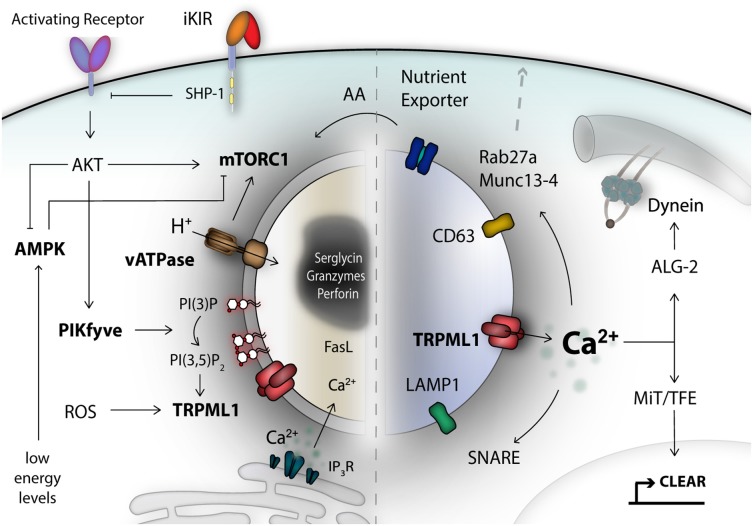Cytotoxic lymphocytes, together with pure killer (NK) cells and T cells are distinguished by their capacity to eradicate goal cells by means of launch of secretory lysosomes.
Conventional lysosomes and secretory lysosomes are a part of the pleomorphic endolysosomal system and characterised by its extremely dynamic nature. Several calcium-permeable TRP calcium channels play an important position in endolysosomal calcium signaling to make sure correct operate of those organelles. In NK cells, the expression of self MHC-specific inhibitory receptors dynamically tunes their secretory potential in a non-transcriptional, calcium-dependent method.
New insights counsel that TRPML1-mediated lysosomal calcium fluxes are tightly interconnected to NK cell performance by means of modulation of granzyme B and perforin content material of the secretory lysosome. Lysosomal TRP channels present a subset-specific expression sample throughout NK differentiation, which is paralleled with steadily elevated loading of effector molecules in secretory lysosomes.
Methodological advances, together with organellar patch-clamping, particular pharmacological modulators, and genetically-encoded calcium indicators open up new potentialities to analyze how TRP channels affect communication between intracellular organelles in immune cells. This assessment discusses our present understanding of lysosome biogenesis in NK cells with an emphasis on the TRP mucolipin household and the implications for NK cell performance and most cancers immunotherapy.

Immunosenescence in persistent HIV contaminated sufferers impairs important capabilities of their pure killer cells.
The HIV/AIDS pandemic nonetheless represents an vital international well being challenge. There is not any sterilizing remedy, subsequently a steady therapy is critical, which brought on the emerged thought of HIV as a persistent inflammatory illness which will additionally have an effect on wholesome ageing.
Considering that the activation profile of some innate cells such as pure killer cells has beforehand been related to HIV development, it stays to be higher outlined this activation standing of NK cells contemplating the time of HIV an infection. In this examine, we characterised NK cell phenotype and performance throughout acute and persistent HIV an infection and in addition investigated markers of immunosenescence in these cells.
Our outcomes confirmed that persistent contaminated sufferers remained with elevated ranges of some plasma inflammatory molecules (IP-10, sCD14) and a concurrent enlargement of the non-functional NK cell subset (CD3–CD56–CD16+). NK cells from the persistent contaminated group displayed an activated profile with larger ranges of cytokines and chemokines manufacturing (TNF-α, IL-12, IFN-α2, IFN-γ, IL-6, RANTES, MCP-1, IL-10, IL-Four and IL-5).
The manufacturing of those molecules was positively correlated to the time of an infection. Moreover, we famous a attainable affiliation of upper international DNA methylation frequency of NK cells in two HIV sufferers in the superior stage of illness. Chronic contaminated sufferers additionally confirmed a development in direction of larger manufacturing of reactive oxygen species by their NK cells which altogether counsel the evolution of those cells to a senescent state that could be additional evaluated.
